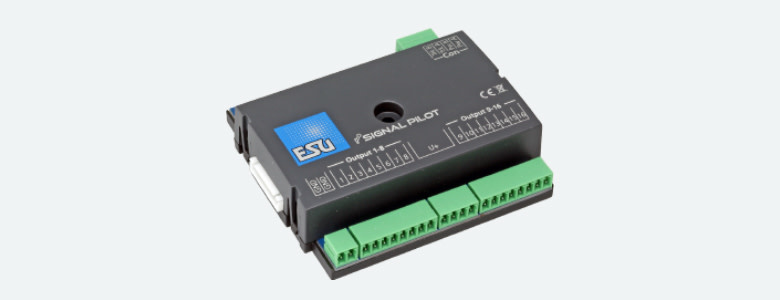The SignalPilot is a multi-protocol accessory decoder designed for switching signals. Due to its intelligent software it can be used under DCC or Motorola®. The flexible programming makes this decoder the all-rounder among our accessory decoders. The SignalPilot has 16 outputs to which the individual micro lamps or LEDs of light signals can be directly connected. Because the outputs are designed as push/pull stages, conventional light signals with a common anode as well as light signals or light strips with a common ground connection (common cathode), as can be found with Viessmann® signals, are suitable. But also motorised shaped signals and point machines can be operated directly with the SignalPilot.
Operating modes
The SignalPilot can be used under DCC with RailComPlus® and Motorola®. Each output can be assigned any address or combination of addresses in the software.
Mode of operation
The SignalPilot can be powered either directly from the digital command station or separately from a DC or AC transformer. You can directly connect the LEDs of two-, three- or 4-word light signals to the 16 outputs. Each output can be operated individually as a continuous light, flashing light or pulse light. The brightness or flashing frequency can be adjusted as well as the fade-in and fade-out times. Various prototypical lighting effects such as soft dimming, neon tube effect, defective neon tube, gas lantern simulation or flickering light ensure a realistic result. Random switching on or off or a switch-on and switch-off delay can also be activated. A night circuit can switch the outputs darker together if desired.
The outputs of the SignalPilot are combined into signal patterns during configuration. In principle, signals with two, three, four or more terms are conceivable. Depending on the number of outputs involved, one or more turnout numbers (turnout addresses) are assigned to each signal, with the help of which you can later switch the individual signal patterns. Up to 16 turnout numbers are available for this purpose.
The configuration of the signal patterns is done exclusively with the help of the ESU LokProgrammer software. You select the desired signal patterns, then transfer them to the decoder and finally wire the signals as configured.
All signal aspects predefined in the LokProgrammer software can be modified individually. The description of the signal aspects themselves is done with the help of XML files, which on the one hand are regularly extended by ESU or can be created and extended by you completely at your own discretion. In this way, even "exotic" signals can be supported. The SignalPilot is multi-protocol capable and can be used with command stations according to the Märklin® Motorola® system (e.g. 6021, Central Station® or Mobile Station®) as well as DCC-capable command stations. The configuration can take place on the main track as well as on the programming track. Thanks to RailCom®, CVs can also be read out.
Optionally, a SwitchPilot Extension relay module can be docked onto the SignalPilot. With its help, e.g. brake sections can be activated or frogs can be polarised.
LokProgrammer
With the ESU LokProgrammer you can easily configure the SignalPilot directly on the screen: Simply select the desired signal type and have the connection displayed directly on the screen.
Future built in
With the help of the LokProgrammer, the SignalPilot's operating software can be updated at any time. This may be necessary if we install further signal types.




